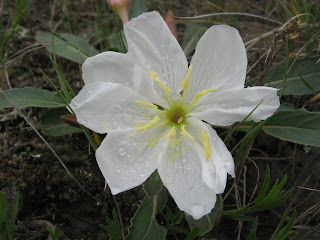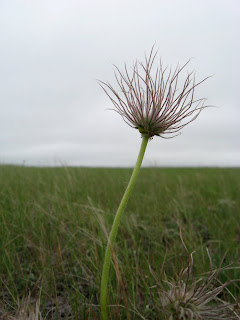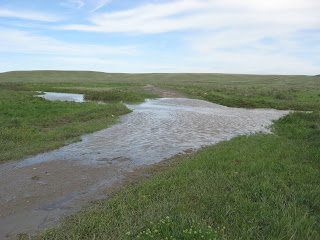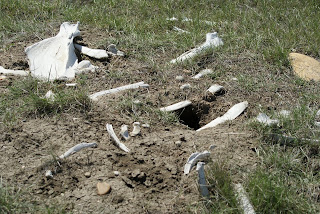I apologize for waiting so long to update, but our internet has barely worked this past week. A combination of 12 people using it and constant cloud cover has made it limp slowly along. Unfortunately, I won't be able to upload any pictures into this post at the moment. When the internet picks up again, I'll add them back in.
A LOT has been happening out here of late. The first was the addition of two plant biologists from Ontario who came to stay for a week and complete some field work. Our already cramped living conditions almost reached a breaking point, and tempers have been running high. With so many people in close quarters, different personalities and clashing wills come to a head. The two extra guys have now left, but this week we're receiving yet another addition, Darcy Henderson, who helped to develop the grazing experiment out here. He comes out every summer to help train the crew on plant identification.
As a continuation of last time, our little baby robins are getting close to fledging. It seems amazing to me that the parents haven't abandoned the nest, what with the constant disturbance of us going in and out of the nest.
Last Sunday (June 6th), we were invited to attend a local branding. I'd never been to one, so I was excited to see what it was like. My first thought upon arriving was horror at the gory process of castrating the bull calves. I was told repeatedly that they heal quickly and with no lasting damage (psychologically as well as physically I hope), but it was still difficult to watch. My next thought was how impressed I was with the efficiency at which the calves were processed. The calves were all inside a corral, and several ranchers on horseback were roping them one by one and hauling them over to where everyone waited. The calf was then wrestled to the ground, branded, castrated (if male), given two innoculations, and given an ear tag. A different person was in charge of each part, so the calf was only restrained for 3-4 minutes. There were three or four "lines" of people waiting to process each animal, so though there were over 100 of them, the entire operation was over in a couple hours.
I wanted to help in some way, so I was allowed to help wrestle the calf down and hold it while it was processed. For only being babies, those calves were STRONG! They definitely didn't like to be poked and prodded, and they let you know it. I had the time of my life though, enjoying the test of my strength against each animal's immensely.
One of my favorite parts was watching one of the horseman. In fact, he was a horseboy. He must have been only 6 or 7 years old, and he was atop this huge horse, roping calves with the best of them. I was immensely impressed with his skill, and how early the children are exposed to their parents' trade.
After the branding was complete, everyone feasted together. I was struck with the overarching sense of community that prevails out here. For an event such as a branding, all the neighbors come to help, and everyone relaxes together after. Everyone knew each other, and most had lived their whole lives here. Much time is spent swapping stories of this relation or that friend. I'd never experienced anything like this close-knit group of people who depend upon each other for their livelihoods.
Thursday night, (June 10) it began to rain. And it didn't stop. It continued all the way through Friday night, leaving the prairie soaked yet again. Apparently this is the most rain this area has had in many years. Even the farmers, who normally welcome and bless the rain, are cursing it. Their fields lay unseeded because the ground is too soggy to plow. Yesterday when we went to check nests, I was horrified to find that many of them were abandoned because of the rain. Chicks, some nearly fully-grown, were left to die in their nests, tiny reminders of the harshness of nature. The only good news about this is that birds re-nest very quickly, so I'm hoping that within a week or two, we will see an explosion of new nests being initiated.
Friday night was open mic night in Val Marie. We missed the last one, and were sad to realize that we'd miss this one as well. With all the rain, the road was unpassable. We decided to attempt a trip last night instead, figuring that if we showed up at the bar with instruments, we could start a second open mic night. Maggi and her crew left before us, as I was waiting for Chris to return from the field. They called and informed us that the road was still very bad, but that they had made it through. Amy and I, who still wanted to go, decided to attempt it. Most of the road to Mankota was fine, but there is a notoriously bad patch that we needed to cross.
Alas, after traveling a mere 30 meters or so into the bad patch, we got stuck. The ruts in the road were over a foot deep into the sticky clay surface. Unable to get any traction, we were trapped. Attempting to call Josh and Chris at the house only resulted in "busy" tones and failed signals. Very luckily for us, a couple pulling a cow trailer on a perpendicular road spotted us. They offered to give us a lift to a nearby house, where the people there would be able to get our truck out. We were left with Debbie Skinner, a wonderful lady who entertained us for the next two hours with conversation and cake. Her husband returned with some friends, and we visited for a while longer, now plied with good drink to supplement the cake. With the guys' help, our truck (which, unlike theirs, had only 2-wheel drive) was out in no time. One of the guys, Kevin, invited Amy and I to a dance a couple towns over, and since we had wanted a night out, we agreed. The dance was a fundraiser for the local hockey team, and we had an absolutely fantastic time. We have so few opportunities to get out, meet new people, and have fun, so when they do come along, we don't take them for granted. Apparently I was a topic of conversation at the dance for being American. I imagine some of the people in these small towns rarely get to meet new people either.
On the way home, Kevin's truck got stuck in the EXACT same place that Amy's had. So at almost 3:00 in the morning, we had to call the Skinners yet again to bail us out. I felt awful about it, but they were as kind and gracious as ever. This goes back to my musings about the community here. If someone is in need of help, you help them without a thought. I've never lived in a place like that, and it's a wonderful feeling. All you need, really, is to meet one person, who can then introduce you to ten more, and suddenly you find yourself invited to all sorts of events. The Skinners invited Amy and I to their branding this coming Saturday, and I can't wait to go. Hopefully I can help repay in part the kindness they showed us yesterday.
I can't believe that June is already half over; the month is flying by. Today was the first hot, sunny day we've had in over a week. Hopefully it's a sign that summer is getting a stronger hold and will beat out the cold and damp once and for all.















.JPG)
.JPG)





































